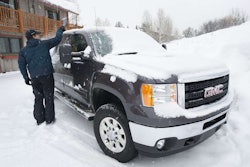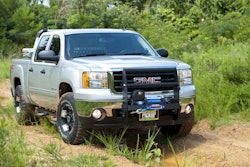Pickup Battery Buyer’s Guide
When it’s time for a new battery should you go with an OEM replacement — or shoot for something bigger and better suited for heavy-duty pickup use? Here’s the asnwer.
By Allan Tarvid (first published 10/10/ 2011)
It’s almost as cold in the shop as it is outside. A crew is waiting at the jobsite and you have a million things to get done before quitting time.
But when you turn the key on the company’s five-year-old diesel pickup, the engine barely turns over.
Dead battery. Time wasted. Money lost.
But it shouldn’t have come as a big suprise becasue there were plenty of little warning signs this truck’s batteries were nearing the end of their life cycle.
Hint number one of impending battery demise was the engine turning over more slowly than usual during cold starts. Hint number two was a noticeable dimming of the headlights when you turned the engine off. Hint number three was the batteries were at the end of their life as indicated by the labels on their tops.
Unfortunately, some sneaky batteries keep their failing health a secret right up until you turn the ignition key and nothing happens. But this wasn’t the case this morning.
CHOOSING THE RIGHT BATTERY
The average OEM battery lasts at least four or five years with proper maintenance unless you ask more from it than it was designed to give.
Maybe you roll down the windows and listen to an amped-up stereo while you work, or leave the headlights on to light up a job when you run out of daylight.
Perhaps you need to run extra lights or a winch, and with the cost of gas and diesel these days you don’t want to leave the engine running.
An occasional dead battery can happen to anyone but if you need regular jump starts because of the way you normally use your truck’s electrical system, you need more battery power than your truck came with so it’s time to step up to a better battery system.
If you need only a little more power, the first and easiest solution is to see if a cranking battery with more capacity is available to fit your truck.
When your truck was designed engineers selected its OEM battery to start its engine and run its factory equipment at the coldest winter temperatures it was likely to encounter. An OEM battery is expected to just start the truck and then serve as a sort of surge buffer while the truck’s alternator carries the electrical system’s load.
BATTERY UPGRADES
Installing anything beyond a standard replacement battery can be tricky.
Your truck’s battery cables may only be long enough to reach positive and negative posts located where they are on the OEM battery and installing a non-OEM model may call for modifying the cable connections.
Speaking as an ex-fireman, never install a battery tall enough for its positive post’s terminal hardware to touch the underside of the hood when you close it! And, tie all batteries down securely so they can’t bounce up and touch the hood!
If your truck is still under warranty it’s also a good idea to talk to your dealer’s service manager to make sure nothing you plan to do impacts your warranty coverage.
UNDERSTANDING BATTERY SPEAK
The main capacity rating for OEM batteries is cold cranking amps (CCA). The CCA number indicates how many amps a new, fully-charged battery at zero degrees Fahrenheit (F) can deliver for 30 seconds without falling below 7.2 volts.
The bigger the number, the longer the battery will crank your engine and the longer you can run a few accessories with the engine off before you risk starting problems.
You may also be able to find a deep cycle or dual-purpose (cranking and deep-cycle) battery from our battery chart that fits in your truck – but first you need to know a few things about batteries.
Lead-acid batteries deliver power as the acid in their electrolyte combines with the lead in their plates.
Turning over a cold engine calls for producing a lot of battery power quickly so cranking batteries are built with a large number of thin plates in order to expose a maximum amount of plate surface area to the electrolyte.
Each engine start causes a relatively shallow depth of discharge in the battery followed by an immediate recharge by the engine’s alternator.
Running accessories with the engine off can result in a deeper discharge, and deep discharge/recharge cycles are hard on battery plates. Purpose-built, deep-cycle batteries have fewer but thicker plates designed to stand up to deep cycling.
Unfortunately, while some deep-cycle batteries have enough plate surface area for engine starting some do not.
The label for any battery used for starting has to carry at least the minimum CCA rating for your truck.
Having more than the minimum rating helps because as you discharge the battery by operating accessories without the engine running you also deplete its cranking amps.
Dual-purpose batteries are designed with plenty of plate surface area for engine cranking and the plates are tough enough to survive moderate deep cycling.
If you accidently run your battery down too far once in a while you won’t hurt this battery as much as you would a pure cranking model.
Dual-purpose and deep-cycle batteries have two more ratings that can help you obtain the capacity you need: amp-hour (AH) and reserve capacity (RC).
The (AH) rating is probably a better indication of how long a battery can sustain smaller amp-draw loads like a non-amplified stereo or lights.
It tells you how many amps a new, fully charged battery can deliver at 80 degrees F, multiplied by the number of hours of use (amps x hours = amp hours), without falling below 10.5 volts.
AH are usually figured over a 20 hour period. For example, a 100 AH battery can deliver 5 amps for 20 hours. You simply add up the number of amps per hour that your accessories draw, multiply the total by the number of hours you want to run them and you come up with the AH rating you need.
RC is a better indicator of how long a battery can run heavier loads like winches and other motorized equipment. The RC rating is the number of minutes a new, fully charged battery at 80 degrees F can carry a 25-amp load without falling below 10.5 volts.
ADDED BATTERY PROTECTION
Your truck dealer’s service department or an automotive electrical shop can also install a volt limiter, a device that turns off power to a chosen set of accessories when the battery is pulled down to the minimum voltage needed to crank your engine.
When you reach that point, the accessories shut down and you know it’s time to fire up the engine and leave it running until you finish the job.
If you want to run heavy accessory loads, or medium loads for long periods of time, you can add an auxiliary battery system: one or more deep-cycle batteries separated from your cranking battery by a battery isolator or automatic charging relay.
Battery isolators completely separate your cranking battery from your auxiliary batteries when the engine isn’t running and the ignition key is off.
Your accessories can run the auxiliary batteries down as far as necessary while your cranking battery stays charged.
Then, when you fire up the engine, the two battery circuits are joined and your alternator recharges all the batteries.
Automatic charging relays (ACRs) are sort of like smart battery isolators. They sense the battery voltage in both the cranking and auxiliary circuits and only combine the two for charging when the voltage of the cranking battery’s circuit rises to about 13 volts and stays there for a couple of minutes.
Typically, this only happens when your engine is running and your alternator is charging the cranking battery.
When the cranking circuit drops below about 12.75 volts for around 30 seconds the relay senses that you’ve shut off the engine and it opens, isolating the circuits so your accessories can’t draw the cranking battery down.
Some ACRs have an under-voltage lockout feature that prevents your cranking battery from being combined with an auxiliary battery circuit that has dangerously low voltage.
Batteries tend to seek the same level when combined and a completely dead auxiliary battery circuit could drag your cranking battery down too low to crank your engine or keep it running. This feature also prevents combining your cranking battery with an auxiliary circuit that is shorted or otherwise faulty.
Your pickup’s electrical system includes expensive components that can be damaged when fed the wrong number of volts!
AUXILIARY BATTERY SYSTEMS
The big advantage of a separate auxiliary battery system is the ability to wire additional batteries in parallel for a virtually unlimited supply of accessory power.
However, if you need to mount more than two big deep-cycle batteries you might check with your dealership’s service manager or a local electrical service shop to make sure you have enough alternator to handle the load.
A single extra battery may fit under your hood, but multiple batteries will probably have to be mounted in the truck’s bed or under the body.
Installing them in securely-anchored marine battery boxes contains any electrolyte spillage, provides safe ventilation and keeps an insulating layer of plastic between the batteries’ posts and your truck’s metal body.
BATTERY TYPES
Batteries come in three types suitable for work truck use. The first and oldest design is the flooded-cell, full-maintenance type.
These have removable caps that allow you to check the electrolyte level in each cell and replenish it as necessary by adding distilled water. This antiquated design remains popular because it continues to provide more amp capacity per pound and per dollar than other lead-acid battery types.
The chief downside to these flooded, full-maintenance models is that they must be checked and serviced regularly, including cleaning their tops and posts as necessary to prevent a buildup of crud heavy enough to leak voltage between their positive and negative posts.
Flooded, maintenance-free batteries also have flooded cells with vented caps but the caps are not removable. These batteries are designed to provide a lifetime of normal use without needing additional water.
The third type is the maintenance-free, absorbed glass mat (AGM) battery. The cell plates in these batteries are separated by layers of tightly packed fiberglass material that absorbs all the electrolyte.
There is no free liquid in the cells and an AGM battery won’t leak even if its case is punctured. No maintenance is necessary or possible, other than a seasonal post and top cleaning if required.
The cells are sealed and must maintain a slight amount of positive internal pressure to function.
AGMs have low internal resistance which lets them deliver power and be recharged very quickly. On the downside, AGMs cost a bit more and are a bit heavier than flooded batteries with similar capacity.
PERILS OF GEL
The terms “AGM” and “gel” are sometimes used interchangeably, to the peril of battery buyers! I would not recommend gel batteries for heavy duty pickup applications.
Charging voltages above 13.8 volts are generally too hot for gel batteries and can drastically shorten their lives. Most vehicle charging systems reach at least 14.4 volts, and I would not want to risk feeding the most expensive type of lead-acid battery that diet on a daily basis.
Upgrading your truck’s battery or adding an auxiliary battery system can be done safely by anyone with sufficient knowledge of electricity and an appropriate set of tools.
But, if you have reservations about doing it yourself it can also be done (and guaranteed) by your pickup dealer or a good automotive electrical shop.
BATTERY CHART CHEAT SHEET
The battery group size number listed for each battery in our chart represents the maximum dimensions of the battery and they are as follows:
BATTERY GROUP SIZE
Maximum LENGTH x WIDTH x HEIGHT
- Group 24: 10.75” x 6.82” x 9.4”
- Group 27: 12.1” x 6.82” x 9.25”
- Group 29: 13.2” x 6.75” x 9.2”
- Group 30: 13.5” x 6.82” x 9.25”
- Group 31: 13” x 6.82” x 9.44”
- Group 34: 10.25” x 6.82” x 7.88”
Four “Special” sized batteries in our chart don’t conform to a standard group size but were included because they have a lot of capacity for their size. Their dimensions are:
- Odyssey PC2250: 11.26” x 10.59” x 9.17”
- Odyssey PC-1800: 22.75” x 4.9” x 12.44”
- Rolls T-12-136: 13.63” x 6.75” x 11.63”
- Rolls T-12-250: 15.38” x 7” x 14.38”
Battery prices in the chart should be considered approximate because dealer profit structures and freight costs vary widely across the country.
BATTERY MANUFACTURERS
For more battery information contact:
ACDelco: (800) 223-3526
Crown: (419) 334-7181
Deka/East Penn: (610) 682-4231
Everstart: Local Wal-Mart store
Exide: (800) 782-7848
Interstate: (866) 842-5368
Lifeline: (626) 969-6886
Odyssey: (800) 538-3627
Optima: (888) 867-8462
Rolls: (800) 681-9914
Sears DieHard: Local Sears or K-Mart store
Trojan: (800) 423-6569








